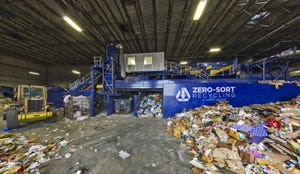Making the Grade?
Refuse fleets testing alternative fuels say it's still too early to tell what the ultimate advantages or disadvantages of their use may be.
Make no mistake about the commitment and cost required to test and ultimately transition a refuse fleet from diesel power to alternative fuels. In many instances, it's not for the faint of fiscal heart.
Refuse collection fleets across the country are anxious to see if the higher sticker prices, increased vehicle weight, the need for new maintenance processes and other issues can be offset over the long-term by the reduced diesel fuel consumption and less wear-and-tear on components and systems. Though the early returns are largely positive, even relatively long-time testers of alternatively fueled trucks don't have a full understanding of their benefits and drawbacks.
Taking It to the Streets

Houston-based Waste Management (WM) offers a prime example of the costs involved with testing alternatively fueled vehicles. Nearly three years ago, the refuse giant committed to $500 million worth of capital spending per annum over a 10-year period to increase the fuel efficiency of its fleet by 15 percent and reduce fleet emissions by 15 percent by 2020. The outlay includes some serious cash for garbage trucks powered by compressed natural gas (CNG) and liquefied natural gas (LNG).
Last year, the company spent $29 million to buy 106 CNG-powered solid waste collection trucks for its Seattle operations and a further $7.5 million to build a CNG refueling station for the vehicles. Within five years, all of its 180 collection trucks in the city will be fueled by CNG, WM says.
WM says the reduction of exhaust emissions is the main reason it's using CNG in Seattle. Smog-causing nitrogen oxide (NOx) emissions are cut by 97 percent with the switch to CNG, and diesel particulate matter (PM) falls by 94 percent and greenhouse gases (GHGs) by 20 percent, WM says.
New York City's Department of Sanitation (DSNY) has had 10 CNG-powered Crane Carrier Corp. LET2 low-entry refuse trucks on the road since early 2009, and the department deployed another 10 units earlier this year. "The CNG trucks are slightly slower off the line in comparison with our diesel-powered units, but other than that there's no difference in performance," says Spiro Kattan, supervisor of mechanics with DSNY's Clean Fuels and Technologies Division.
Still, Kattan says a firm verdict on alternatively fueled vehicles is still a ways off. Tracking their performance in various types of weather needs to be further explored, he says.
"As we operate in the Northeastern U.S., we're subject to big swings in temperature," Kattan points out. "Though we had a lot of snow during this past winter, we didn't have really long stretches of freezing temperatures. We need that 'real world' cold for truly testing our CNG trucks."
Plowing snow is another operation for which more data is needed. "We equip all of our refuse trucks with snow plows, to aid in snow-removal operations," Kattan says. "So we need to track the snow plow performance of our CNG-powered trucks over several snowstorms to get an accurate gauge of their capability. You can't depend on just one or two snowfalls to give us the data we need. The more information we gather, the better."
The same issues apply to the other alternatively fueled vehicles DSNY is testing: a Mack TerraPro low-entry, parallel hybrid diesel-electric truck; a Crane Carrier low-entry diesel hybrid equipped with a Bosch Rexroth Hydrostatic Regenerative Braking (HRB) parallel hydraulic system; and a Crane Carrier low-entry model equipped with an ISE diesel-electric hybrid series drive system.
Each is being evaluated in terms of fuel savings, emission reductions, component life, maintenance costs, reliability and uptime, as well as any operational issues observed by drivers. "We need time to get to a point where we have enough solid data to draw true comparisons between these technologies and traditional diesel-only trucks," Kattan notes.
Regional Differences

VARIETY IS THE SPICE OF PILOT TESTS: New York City sanitation officials are testing both CNG-fueled trucks and hybrid vehicles.
Of course, where refuse trucks operate affects the long-term calculations of using alternative fuels.
DSNY noted that its Mack and Crane Carrier trucks — each of which has a gross vehicle weight of 72,000 pounds — are deployed in regular residential trash collection service, across the multitude of driving patterns and duty cycles present in an area the size and scope of New York City.
Now contemplate similar tests being undertaken by the city of Denver — a place that adds in factors that New York City doesn't experience, such as more frequent and heavier snowfalls, long stretches of extremely cold temperatures, and the impact of high altitude. Nancy Kuhn, fleet administrator for Denver's fleet management division, said B20 biodiesel, which consists of 20 percent soybean-based biodiesel and 80 percent regular diesel fuel, has been fueling all of the city's diesel-powered vehicles and equipment (about 850 units), including its fleet of 120 trash and recycling trucks, since 2004 with no problems.
Denver tapped biodiesel for a simple reason: it was the easiest alternative fuel to implement, with no modifications required to its vehicles or maintenance facilities and a $1 per gallon federal biodiesel tax credit making the transition affordable. We've gone to B10 on occasion to remain within budget, she says. "But in 2010, grant money offset the incremental costs of using this alternative fuel."
Hybrids are Denver's next area of research, with 142 hybrids operating in its fleet, among them a heavy-duty Peterbilt hybrid trash truck equipped with Eaton Corp.'s Hydraulic Launch Assist (HLA) technology. "Our hybrid-hydraulic trash truck is considered a test unit, allowing the manufacturer to gather fuel data and monitor performance and brake wear in Denver's high-altitude, cold-climate conditions," Kuhn says.
"We felt the HLA technology would be effective in stop-and-go trash collection operations, and it has been well-received by the [waste department]," she said. "So far, it's getting 25 percent better fuel economy than its non-hybrid counterparts."
Kuhn added that the city is pinning multiple hopes on its heavy-duty hydraulic-hybrid refuse truck, such as reduced exhaust emissions, decreased petroleum consumption, and better resale value especially if fuel prices spike again.
Save Me the Money

ROCKY MOUNTAIN HYBRID: The city of Denver is testing a hybrid trash truck and reports that it features a 25 percent better fuel economy than its non-hybrid counterparts.
One of the major keys, of course, to the long-term viability of any alternatively fueled vehicle boils down to two words: costs savings. Recent research by the Phoenix-based WIH Resource Group, a waste industry consulting firm, determined that alternative fuels, in particular natural gas, can be a money-saver, but primarily over the long haul.
In a white paper WIH titled "Alternative Fuel Use in Refuse Collection Vehicles," the company determined that the biggest savings occur when refuse truck operators are able to get fixed-price, multi-year natural gas fueling contracts from suppliers. Under this scenario, the average price of natural gas, compared with traditional diesel, is about $1 less per diesel gallon equivalent (DGE). Without such contracts, natural gas typically runs about 50 cents per DGE cheaper than diesel, the group noted.
The use of natural gas as a vehicle fuel also helps reduce U.S. dependence on foreign crude oil, WIH says. For example, in 2005, 64 percent of the crude oil used in the United States was imported from foreign sources other than Canada. By comparison, an estimated 97 percent of the natural gas used in the United States that same year came from domestic or Canadian sources, thus making natural gas less vulnerable to foreign supply disruption and price volatility. The CNG market also tends to be more stable than the gasoline market, typically costing anywhere from 15 percent to 40 percent less than gasoline or diesel, WIH says.
However, CNG-powered trucks require more frequent refueling, because the gas contains only about a quarter of the energy by volume of diesel. Also, CNG vehicles cost $1,500 to $3,500 more per year than their diesel-powered counterparts, primarily due to the higher cost of maintaining the CNG fuel-storage cylinders on the trucks.
Yet once new natural gas trucks are in service, WIH found, their operators stand to save money. Not only is the price of natural gas trending lower than that of diesel fuel, an excise tax credit available under the federal 2005 Energy Policy Act has made CNG an even better bargain in some cases. For example, WIH estimates one city's 20 CNG trash trucks could produce fuel savings of more than $157,894 per year over diesel fuel, in no small part because of those tax credits.
Potential savings like that are one of several reasons why many refuse fleets — in the public and private sectors alike — continue to experiment with a wide variety of alternative fuels, even though a complete operational picture of their benefits and drawbacks has yet to be painted.
Sean Kilcarr is the senior editor of Fleet Owner, a sister publication of Waste Age.
Related Stories
About the Author
You May Also Like


